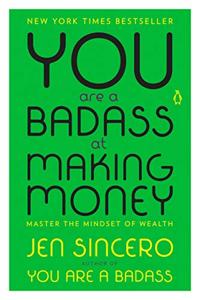
Want to learn the ideas in You Are A Badass At Making Money better than ever? Read the world’s #1 book summary of You Are A Badass At Making Money by Jen Sincero here.
Read a brief 1-Page Summary or watch video summaries curated by our expert team. Note: this book guide is not affiliated with or endorsed by the publisher or author, and we always encourage you to purchase and read the full book.
Video Summaries of You Are A Badass At Making Money
We’ve scoured the Internet for the very best videos on You Are A Badass At Making Money, from high-quality videos summaries to interviews or commentary by Jen Sincero.
1-Page Summary of You Are A Badass At Making Money
Overview
We all want more money. However, most people have negative feelings about it and the people who make it. This negativity is holding us back from achieving our financial goals. Let’s overcome these limiting beliefs so we can achieve economic success!
In this article, you’ll learn that wanting money doesn’t make one greedy. You have to get out of your comfort zone if you want to become rich. Jim Carrey wrote himself a $10 million check and then cashed it when he was broke.
Big Idea #1: Many of us have a conflicted relationship with money that keeps us from reaching our potential.
Money is a complicated subject. Some people love it and others hate it, but the truth of the matter is that money isn’t going to go away anytime soon. This means we need to learn how to deal with it properly. We can do this by debunking myths about money like the one which says that having too much of it makes you greedy and selfish, as well as learning from philanthropists and activists who use their time and energy for good causes because they have enough money to do so.
We can have mixed feelings about wealth. Sometimes, we feel good about having a lot of money. Other times, however, we feel bad for wanting it or not having enough of it. For example, if you see someone with an expensive TV and then think that you want one too, your attitude towards wealth might change because you don’t like seeing how much the other person has compared to how little you have.
A lot of people believe that if one person becomes rich, it means someone else has to become poor. This is a common misconception because people have a poverty mindset. They think there’s not enough money to go around and that they’re taking from others by becoming richer themselves. However, this isn’t true at all—it’s more like you’re creating opportunities for other people by working hard and making yourself successful so you can buy your own sandwiches and help them with theirs as well! Sincero used to feel the same way about money but now she helps others avoid wasting their time with low-paying jobs because she wants them to start earning big bucks right away.
Big Idea #2: Money isn’t inherently evil; it’s simply an effective way of conducting business.
Money is neutral. It’s up to us to make it evil or good by how we use it. Money was invented as a way of doing business without bartering, which had become inconvenient.
In the past, you could get a nice fur coat by building a stone wall. Or noblemen might trade their daughters for seaside castles. These transactions were complicated and involved lots of yelling. In contrast, currency made it easier to acquire goods because merchants simply gave you what you wanted in exchange for money.
Money is not inherently evil. It’s more accurate to see it as a tool that helps get things done efficiently. Think about cars and computers: Are they evil because some people use them for bad purposes? The answer is no, so why do we say money is evil when people use it for bad purposes? The blame should be placed on the individuals who commit these acts of violence rather than on the cash itself.
Here’s a way to help you stop thinking of money as an evil thing.
Since these negative qualities are usually reserved for people, try writing two “Dear Money” letters to explain your feelings. The first letter should be written as if you were addressing a person who represents money and explains why you’re angry with that person. The second letter should be written as if you were addressing the same person but explaining how they’ve helped you in some way. Once you’ve finished writing both letters, read them out loud. You’ll realize that your anger is unjustified because of the logical reasons expressed in each letter.





